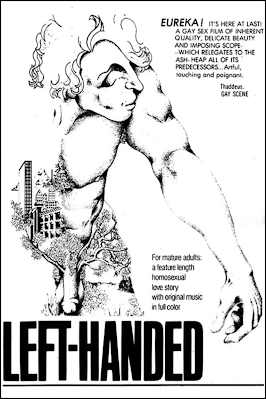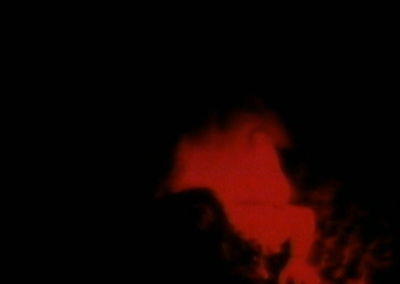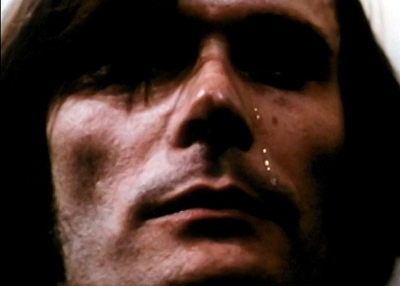Though the U.S. QAnon party would have its base believe that trans people are a recent phenomenon, dating back to when the Obama administration, colluding with Hollywood elites and woke millennials, performed gender reassignment surgeries on unsuspecting preschoolers as part of a sinister plot to send them into our nation’s schools as trans adults to read books to kids and compete on varsity swim teams, it turns out that they have been around significantly longer than the 2010s.
In fact, way back in 1970—a good 53 years after the first gender affirming surgery was performed in the U.S.—Hollywood released two very different films centering on trans women (but played by cis-gendered actors): the turgid biopic THE CHRISTINE JORGENSEN STORY, and the botched adaptation of Gore Vidal’s 1968 satirical novel, MYRA BRECKINRIDGE.
 |
| Christine Jorgensen in the 1950s. |
But despite the crass exploitation of the movie’s marketing (“Did the surgeon’s knife make me a woman or a freak?” reads the poster), the actual film shows far more sensitivity in its handling of Jorgensen’s story (Jorgensen herself is credited as the movie’s technical advisor). That story begins, predictably, with Jorgensen’s unhappy childhood as George, Jr. (Trent Lehman), a boy more inclined to play with his sister’s dolls and his mother’s makeup than play football. His concerned mother tries to steer George, Jr. toward more traditionally masculine pastimes, while George, Jr.’s father does his level best to convince himself his boy is just going through a phase. He’s encouraged—overjoyed, even—when George, Jr., having taken on some school bullies, comes home with a black eye. “You’re going to remember that black eye as one of the proudest moments of your life,” he tells his son, going so far as to take a photo of George, Jr.’s shiner.
 |
| Is this fucked up or what? |
 |
| Loretta, the cunty model. |
 |
| Are you trying to seduce me, Mr. Warner? |
George, Jr., heads to the library, where he discovers the book Sex and the Glands by Dr. Stephen Estabrook. The book proves so enlightening that George enrolls in the doctor’s college course just to speak to him about his theories. After explaining to the endocrinologist that he’s always felt his instincts and impulses are female, Estabrook (Will Kuluva, who really could’ve benefitted from a Klipette) takes some blood for testing. The test results confirm that George has a chemical imbalance. “Your glands are secreting more female hormones than male—three times higher than expected in a normal man.”
 |
| A penectomy is exactly what you think it is. |
A couple montages later, Christine is born, her name selected in honor of the late daughter of her Aunt Thora, with whom she’s been staying (in actuality, the name was chosen in honor of endocrinologist Christian Hamburger). While Christine, now looking like a young Rosie O’Donnell in Doris Day drag, is pleased with the superficial aspects of her transition—there are lots of shots of her modeling the dresses her aunt’s made for her and patting her hair—she’s hesitant to fully live as a woman, which, as far as this movie goes, means she needs a man.
 |
| From man to matron. |
 |
| Christine Jorgensen's transition is front page news. |
However, one reporter, Tom Crawford (Quinn K. Redeker, who would later have a hand in writing The Deer Hunter), approaches Christine as a person, not a freak. Christine works with Tom, allowing him daily interviews for an in-depth magazine story, only to back out before the article’s completion when she suspects Tom has feelings for her. This is for Tom’s protection; sooner or later, he’ll see her as an oddity. “Are you going to stop reading the newspapers? Or listening to the radio? Or watching television? Will they ever stop making jokes? They’ll never stop laughing.” Tom is undeterred, and urges “Chris” to stop being afraid. The pair kiss, then slowly sink onto the sofa in a love scene that could be right out of a 1950s Douglas Sirk film.
In fact, except for its subject matter and featuring some nudity, The Christine Jorgensen Story could easily be a product of the 1950s. This is likely attributable to director Irving Rapper, who helmed several Bette Davis movies, including Now, Voyager and Another Man’s Poison. In Rapper’s hands, The Christine Jorgensen Story is just an old-fashioned melodrama with a twist. Rapper’s approach keeps the movie from becoming exploitative, but it also heightens its campiness.
 |
| When Christine dreamed of doll murder. |
That campiness is heightened further by the acting. Trent Lehman—yet another child actor who came to a sad end—portrays George, Jr., not as a child wrestling with gender dysphoria but as a future school shooter. When George, Jr.’s mother takes a doll away from him, we suspect she’s more concerned that he might dismember it than she is about her son conforming to gender roles. John Hansen’s performance, while earnest, often becomes parodic, the actor’s pearl-clutching rendering Jorgensen an object of pity rather than someone driven to live her life on her terms.
Ultimately, it’s this portrayal of Jorgensen as a hypersensitive soul in need of a hand to hold as she faces the big, bad world that is the movie’s downfall. The real Jorgensen was an outspoken trans activist, described on her Wikipedia page as having been known for her “directness and polished wit,” qualities you can see in her TV interviews (you can also see some of the shit she had to put up with in this clip). Where you won’t see those qualities is in The Christine Jorgensen Story.
‘The Most Extraordinary Woman in the World’
There is no political correctness to be found in Myra Breckinridge, which not only treats the very concept of sexual reassignment surgery as a joke, but is also peppered with casual homophobia and racism, and features a scene of female-on-male rape played for laughs. Even more horrifying, it not only includes Rex Reed (yes, the very same) in its cast, it features a scene of him masturbating. I’ll take the rape scene, thank you.
 |
| Gore Vidal's novel is great. Its film adaptation less so. |
And then 20th Century Fox gave the job of writing and directing to Michael Sarne.
In Sarne’s hands, Myra Breckinridge went from being a biting satire on sexual mores to a mashup of the “hip” movies of the late ’60s with the comic sensibilities of the stupid softcore sex comedies found later in the ’70s (think I Love You, Alice B. Toklas crossed with Dagmar’s Hot Pants, Inc.) and edited by monkeys on Adderall. In short, it’s a hot mess (with an even messier production). Yet, despite Sarne’s best efforts to rob the film of any entertainment value whatsoever, there is still some fun to be had here.
At the film’s opening, film fanatic Myron Breckinridge (Reed) is about to undergo gender reassignment surgery, performed by a chain-smoking John Carradine in an operating theater that resembles a partially struck set from Barbarella. There’s also a seated audience and a young woman who spends the entire scene cracking a big, fat whip because…1960s wackiness? “You know, once we cut it off, it won’t grow back,” the doctor warns Myron. “How about circumcision? It’s cheaper.”
Nevertheless, Myron is transformed into Myra (Raquel Welch). Before you let out a sigh of relief that Rex Reed has been transformed into someone else, be warned that he pops up throughout the movie as Myra’s ghostly alter ego with whom she discusses her plans.
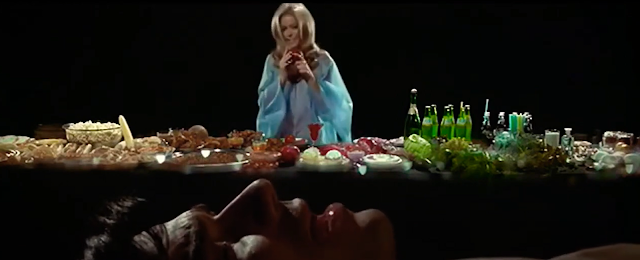 |
| And sometimes Rex Reed is just there to masturbate while dreaming of a young Farrah Fawcett presenting a table full of food, a scene that will make no more sense when viewed in context. |
Her primary agenda, Myra explains, is “the destruction of the American male in all of its particulars.” As grand as that goal is, her battlefront is the much more modest acting school owned and operated by her uncle, ex-movie cowboy Buck Loner (John Huston, in what would ordinarily be a Slim Pickens role). Myra shows up at the school claiming to be Myron’s widow, and as such, she wishes to claim Myron’s half of the school, or $500,000. Buck balks, but reluctantly gives her a teaching job at the academy while he investigates Myra’s claims.
 |
| Roger Herren as Rusty. No wonder Myra was smitten. |
Myra’s goal of bringing down the American male also includes women, apparently. Viewing Rusty’s girlfriend Mary Ann (Fawcett) as an embodiment of traditional gender norms, Myra also seeks to seduce—and therefore “destroy”—her as well. However, Mary Ann is not as easily conquered as Myra first suspects. “I’m sorry, I just can’t. If only there was some man like you.”
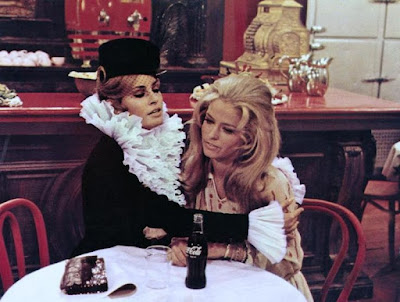 |
| Sorry, guys. No Raquel-on-Farrah action ever happens. |
Then there is Hollywood agent Leticia Van Allen. In the book, Leticia is a brassy, horny older woman who joins forces with Myra. The producers of the movie were on the right track when they sought out a veteran of Golden Age Hollywood for the role, except Golden Age stars weren’t too eager to star in what was believed to be a dirty movie (Bette Davis was approached about the role and adamantly refused, and yet she agreed to star in Bunny O’Hare). Not Mae West, who was a spry 77 years old at the time. West hadn’t appeared in a film since 1943’s The Heat’s On, and it’s clear from her first appearance in Myra Breckinridge that she hadn’t updated her schtick in the intervening decades. “I don’t care about your credits as long as you’re oversexed,” she tells one young actor, played by a pre-fame Tom Selleck (“That’s one of my credits!” he gleefully replies). Another young hopeful tells Leticia that he’s 6'7". “Never mind about the six feet. Let’s talk about the seven inches.” It goes without saying that West wrote her own dialog.
 |
| So, is this a stand-in? |
 |
| Mae West and Raquel Welch, hiding their mutual hostility, though it appears only Mae is succeeding. |
Speaking of scenes from old movies, they are used throughout Myra Breckinridge either as commentary, a gag, or to punctuate a scene in the movie proper, and often to the chagrin of their stars (Loretta Young sued; Shirley Temple, having served as a U.S. ambassador, got the White House involved). Sometimes the clips are used cleverly, but mostly they are overused. Like Mae West, they only serve to distract from an already fractured narrative. (For someone who reportedly once wasted several days filming a table of food for this movie [see above], Sarne can’t seem to stay with one scene long enough for anyone to figure out what the fuck is going on.)
 |
| Myra takes Rusty's temperature. |
There’s no mistaking what’s going on when Myra, under the pretense of getting some medical data, dons a strap-on and rapes Rusty (though the movie initially received an X rating, the dildo is never once shown on camera). And this is in the name of comedy, no less, though most of the laughs come from the bizarre sight of Raquel Welch, one of the premier sex symbols of the 1960s, pegging a stunned stud. This rape scene is in the book as well, and there the humor is a bit meaner, and highlights how the character of Myra Breckinridge isn’t really a trans woman so much as she is a gay man who has gone to extremes to put cis-het men (and their girlfriends) in their place. (In the book, Myra is impressed by Rusty’s rectal hygiene, noting most straight men don’t clean their asses properly.) Back when I first read the book as a closeted teen-ager, I felt Myron had been surgically transformed into a beautiful woman for the same reason Charles Bronson got a gun in Death Wish: retribution. Though it would seem Rusty is hardly worthy a target for said vengeance, he represents, to borrow a line from the movie, “the last stronghold of masculinity in this Disneyland of perversion.” Consequently, Myra wants to destroy him as much as she wants to fuck him, so consider this scene as killing two birds with one dildo. Still, it might have worked better if Rusty were more of a toxic masc asshole instead of just kind of dumb.
 |
| Myra Breckinridge prepares to destroy Rusty (and dat ass). |
 |
| A perplexed Raquel Welch tries to make sense of Myra Breckinridge. |
 |
| Presenting the most extraordinary woman in the world. |
The Christine Jorgensen Story may be a better movie by comparison, but Myra Breckinridge, with its lead character written as a strong woman/fierce gay man rather than a self-loathing closet case/fragile wallflower, is more empowering (provided you don’t get too hung up on the rape scene, of course). It’s still a trainwreck, but that just makes it worth seeing all the more. You can do so here.
BONUS MATERIAL: People often have as much fun, if not more, discussing a notorious bomb than viewing it, especially when said bomb goes on to attain cult status. Consequently, there are an abundance of articles, reviews and think-pieces about Myra Breckinridge. Here are a few worth checking out:
Dreams Are What Le Cinema is For… has a very thorough review that includes all the gory details about Myra Breckinridge’s production, as well as much higher quality stills from the movie (that’s what I get for not investing in the DVD).
My Year of Flops Case File #19: Though I disagree with his assessment of Reed’s performance as an “unexpected highlight of the film” (it’s a not-terrible performance by an otherwise terrible person, and that’s the most praise I can allow), Nathan Rabin’s review of this film—indeed, the whole My Year/World of Flops series—is not only a fun read, but a reminder of how good the A.V. Club site used to be.
Myra Breckinridge and Trans Roles on Film: James Gent takes a more serious look at the film and its place regarding trans representation in film.
2012 Q&A with Raquel Welch: Though Welch initially tried to distance herself from this career disappointment, she eventually lightened up and laughed along with everyone else. In this Q&A with a starstruck Simon Doonan she talks about her experience in making the film, with a good portion spent dishing on Mae West. R.I.P., Raquel.
*Welch herself wasn’t exactly known for being a delight on set.




